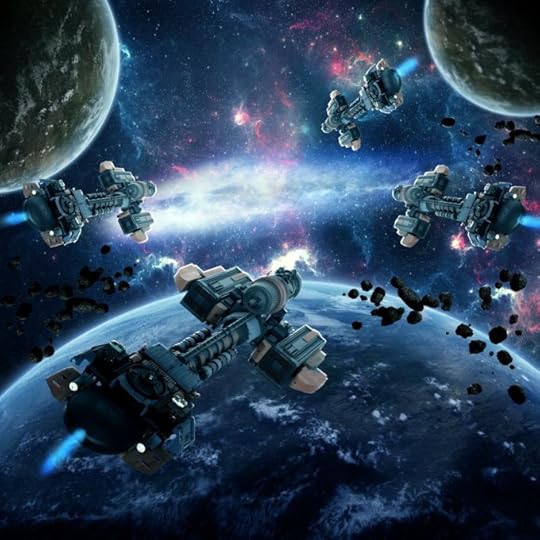Writing an Epic Battle Sequence
Writing an Epic Battle can be tremendously difficult if you don’t know what you’re doing. I suppose that can be said for a lot of different aspects of a story. I learned this particular lesson the hard way. This article is more for my own personal memory aid to look back on as I write Epic Battles in the future, though if this helps someone else along the way, all the better.

Going in, I already knew what I wanted to achieve. I wanted to write the next great movie action sequence… The first mistake I made was treating a book like it was a movie. If you’re anything like me, there’s something thrilling about this sort of action on the big screen, whether the Avengers are fighting the many replicas of Ultron, or a team of inexperienced fighter pilots are trying to destroy the Death Star, that just awakens your imagination. And then you’re totally thrilled at the prospect that we, as authors, get to write that sort of thing. And, in some respects we can, but there is something distinctly visual that cannot be achieved with words alone.
You will find that many successful authors avoid writing fight scenes. You will find that many hopeful readers will actually skip the fights in your books to get to the “good part”, even if you thought the battle was the “good part”. You will find that many well-intentioned authors who write exceptional action sequences, will discourage others from doing so.
They say it can’t be taught. They’re right. It requires a fair amount of intuition. You cannot teach a hopeful writer to craft an action sequence any more than you can teach a hopeful teen with a sharpened pencil and a notebook to write a meaningful poem. (I say this because, as a teen, when asked to write meaningful poetry, I wrote a poem about classmates who wore too much perfume. [A sample of said poem? Alright…]
I grieve that you reek putridly
In that stink cloud how do you see?
I tried to tell you, but gagged far more
Then taped this to your locker door.
That poem didn’t impress my English teacher, though apparently my old math teacher still has it hanging on the wall in his classroom after 12 years. Thanks for the encouragement, Mr. Harvey!)
Getting back into the part of this article that’s actually helpful (and leaving nostalgia behind), I discovered a few tricks in this endeavor that made the battle scene work for me. And though you will indeed have to figure out the rest for yourself, perhaps this might be some additional advice.
First off, it can be intimidating to write an action sequence. But no matter how much reading of silly books about fight scenes you delve into, you still have to get the words into your word processor yourself. Can listening to the right kind of music help? Possibly. Can it also delay your work while sifting aimlessly through Pandora playlists? Certainly. Can you look to the greats for their advice? Advice on this sort of thing is plentiful. But if you’re still searching for advice after you’ve read the greats (and that’s a real possibility as you’re reading an article by me), and reading through the stories that have truly epic fight scenes for inspiration, you must consign yourself to either of two options. First, you will give up this pursuit and try writing comedy stories about teddy bears and trains for toddlers instead. (Check!) Second, you will grit your teeth and get down to the business of writing your heart out. And trust me, when you finally get past the “can’t do it” to the “can”, it may very well become easier than you expected.
To begin your fight scene, it helps to know what the characters are fighting about, and having an idea of what they will look like afterward. If your heroes are still standing without a scratch on them while your villains are in a pile on the floor, you probably did something wrong. There’s a good chance that someone will lose something they cared about and planned to use later. (Visualize that. Then figure out how it happened and work backward.)
Next, put your imagination to work. As with any action your character takes in a story, you cannot push aside characterization with an action scene. So you must really see your protagonist and supporting characters do what you are writing about them. Trust your imagination. If your protagonist is about to get creamed in the fight, don’t make him the hero he can’t be. Then, consider how you can use your character’s strengths to gain the victory. For example, perhaps your character doesn’t know a pommel from a rain guard, in which case, giving him a sword will be useless. Perhaps he doesn’t know how to turn off the safety on the rifle he’s been given. Not that you don’t give him a blade or a rifle anyhow, but if he’s incompetent, this should be readily evident.
It can be a lot of fun to pit your character against another he has no real shot of beating, and it makes your readers cringe, which is actually a positive response. There is something thrilling about a hero backed into a corner with no way out. But, this likewise has two outcomes. Either your character will reach a tragic end or find another solution your reader hadn’t thought of.
Usually, it is best to find something about your character’s unique skill-set that can get the job done, rather than relying on outside interference. However, if your character must rely on outside interference, make certain your audience is aware that the outside interference is plausible. Deus Ex Machina, the rescue from nowhere, kills your story and your reputation as a writer. Even subtle hints at the possibility of outside interference work well. Another possibility that works well, if you must use outside interference in your story, is to make the rescue lead the character into an even worse situation than she was in already. Have the outside interference come from the villain himself, for example. The hero is facing a thug when suddenly a gigantic monster races in, bites the thug in half and licks his lips. Now the peril is just as real, but the problem is of a different nature. Perhaps your character has a stick of bubble gum in her purse. The thug doesn’t like bubble-gum, but the gigantic monster catches the gum in his teeth, chews it until his mouth is stuck shut, and your hero makes her escape. (There could be worse plots.)
Another challenge of the epic battle is too many characters to control. This is rather simple. Consider which of your characters are important enough to merit their own scene in the battle, and write these parts. Use your additional heroes and villains to season the scene, adding twists and turns to the conflict. (It is best if your supporting heroes and villains are quite competent, so that your reader doesn’t need to wonder about them while fully engaged with your protagonist.) If you don’t focus on too much at once, the scene becomes far easier to write. If something your supporting character is going to do merits a paragraph, have this character cut across your hero’s path while doing his heroic deed. Your audience will get a glimpse of his presence without losing sight of the focus character.
These are just a few of the tricks I’ve begun to unearth in my pursuit of an epic battle. (You might naturally find that I used these tricks in my Forgotten Princess series.) Perhaps you have found other tricks of the trade. When we learn from one another, all of our works become better as a result. Therefore, what have you found that works for you? Feel free to share below.


 newest »
newest »





As for tricks of the trade, when I've written an epic battle I'm truly happy with, I'll chime in.